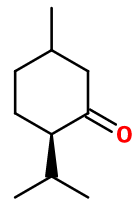
Photo credits: ScenTree SAS
Isomenthone
Isomenthone DL ; Menthan-3-one ; 5-methyl-2-propan-2-ylcyclohexan-1-one ; 2-isopropyl-5-methyl-cyclohexanone ; Cis-para-menthan-3-one ; 5-methyl-2-(1-methylethyl)cyclohexanone ; 5-methyl-2-(isopropylcyclo)hexanone ; 2-isopropyl-5-methylcyclohexanone

Photo credits: ScenTree SAS
| Company | Ingredient Name | ID | Comments | Naturality | Certifications | Purity | Latin name | Treated part | Geographical origin | MOQ |
|---|---|---|---|---|---|---|---|---|---|---|
|
|
Isomenthone - 30gr | - |
Visit website
|
- | - | - | - | - | - |
General Presentation
-
CAS N° : 491-07-6
-
EINECS number : 207-727-4
-
FEMA number : 3460
-
FLAVIS number : 07.078
-
JECFA number : 430
-
Appearance : Colorless liquid
-
Density : 0,992
-
Volatility : Head
-
Price Range : €€
Physico-chemical properties
-
Molecular formula : C10H18O
-
Molecular Weight : 154,25 g/mol
-
Log P : 2,7
-
Fusion Point : -35°C
-
Boiling Point : 208°C
-
Detection Threshold : Donnée indisponible.
-
Optical rotation : Donnée indisponible
-
Vapor pressure : Donnée indisponible
-
Refractive Index @20°C : Donnée indisponible
-
Acid Value : Donnée indisponible.
-
Flash Point : 85°C
Uses
Uses in perfumery :
Isomenthone is poorly used in perfumery, because of its dirty note. Used in majority in functional perfumery, more than in fine fragrance.
Year of discovery :
Data not available.
Natural availability :
Isomenthone is found in several species of mint, including Peppermint EO, of which it is one of the major components. It is also found in Geranium EO, whatever its origin. Thus, Isomenthone can be extracted from these different natural raw materials, although, it is difficult to obtain it with a great purity.
Isomerism :
Isomenthone is a diastereoisomer of Menthone®. Both also have a pair of enantiomers : Menthone® have a much colder and alimentary smell and Isomenthone are greener and more terpenic. These molecules are difficult to obtain with a high purity because the isomers have a tendency to interconvert. In perfumery, the most used Isomenthone is its enantiomers mixture. In addition, Isomenthone is a constitutional isomer of Borneol in particular. Both provide a refreshing effect in compositions, but Isomenthone is more suitable for mint reconstitutions.
Synthesis precursor :
Menthone® and Isomenthone are used to synthesize Menthol isomers by hydrogenation. The choice of the starting isomer is important. For example, using a laevorotatory Isomenthone leads to the formation of laevorotatory Neomenthol and dextrorotatory Menthol.
Synthesis route :
Isomenthone can be obtained synthetically from Menthol or Thymol. From Menthol, an oxidation reaction of the alcohol function is carried out to obtain a ketone function. The choice of the Menthol isomer (for example L-Menthol) is important to guide the nature of the final product. From Thymol, a hydrogenation in the presence of a palladium on carbon catalyst is necessary. In all cases, several isomers are obtained at the end of the reaction. These can be separated by a fractional distillation to collect the isomers of interest only.
Regulations & IFRA
Allergens :
This ingredient does not contain any allergen.
IFRA 51th :
This ingredient is not restricted for the 51th amendment


